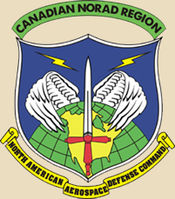1 Canadian Air Division
| Canadian NORAD Region / 1 Canadian Air Division | |
|---|---|

Canadian NORAD Region Emblem
|
|
| Active | June 1, 1983 – present |
| Country | Canada |
| Branch | Royal Canadian Air Force |
| Type | Aerospace warning and aerospace control |
| Role | The mission of the Canadian NORAD Region (CANR) is to provide aerospace surveillance, identification, control and warning for the defence of Canada and North America. |
| Size | Headquarters has 600 regular and reserve force members |
| Part of | Part of North American Aerospace Defense Command (NORAD) |
| Garrison/HQ | CFB Winnipeg, Manitoba, Canada (1 April 1997 – present); North Bay, Ontario, Canada (1 June 1983 – 31 March 1997) |
| Colors | Blue, green, yellow, and silver |
| Anniversaries | June 1 |
| Website | www |
| Commanders | |
| Jun 2016–Present | Major-General Christian Drouin |
| Ceremonial chief | Major-General David Wheeler |
| Jul 2012 – Jul 2014 | Major-General Pierre St-Amand |
| Jul 2011 – Jul 2012 | Major-General Alain Parent |
| Jul 2009 – Jul 2011 | Major-General Yvan Blondin |
| Jul 2007 – Jul 2009 | Major-General Marcel Duval |
| Aug 2004 – Jul 2007 | Major-General Charles Bouchard |
| Jul 2002 - Aug 2004 | Major-General Marc Dumais |
| Jul 2000 - Jul 2002 | Major-General Steve Lucas |
| Roundel |
 
|
| Fin flash |
|
| Aircraft flown | |
| Fighter | CF-188 Hornet |
| Helicopter | CH-124 Sea King, CH-139 JetRanger, CH-146 Griffon, CH-147 Chinook, CH-148 Cyclone, CH-149 Cormorant |
| Patrol | CP-140 Aurora, CP-140A Arcturus |
| Reconnaissance | CU-170 Heron |
| Trainer | CT-114 Tutor, CT-142 Dash-8, CT-155 Hawk, CT-156 Harvard II |
| Transport | CC-115 Buffalo, CC-130 Hercules, CC-130J Super Hercules, CC-138 Twin Otter, CC-144 Challenger, CC-150 Polaris, CC-177 Globemaster |
1 Canadian Air Division (1 Cdn Air Div) (French: 1re Division aérienne du Canada) is the operational-level command and control formation of the Royal Canadian Air Force (RCAF). Prior to 2006 the official abbreviation for the division was 1 CAD. It is commanded by an air force major-general.
The division traces its origins to the activation of Headquarters No. 1 Air Division, Royal Canadian Air Force in Paris, France on 1 October 1952. Air Division headquarters relocated to Metz, France in April 1953. No. 1 Air Division was established to meet Canada's NATO air defence commitments in Europe. It consisted of four wings of twelve fighter squadrons located at four bases. Two bases were located in France (RCAF Station Marville (No. 1 Wing) and RCAF Station Grostenquin (No. 2 Wing)) and two were located in West Germany (RCAF Station Zweibrücken (No. 3 Wing) and RCAF Station Baden-Soellingen (No. 4 Wing). ( No. 1 Wing was first located at RCAF North Luffenham, England and was moved to Marville some time after October, 1954). These wings were part of a group of bases which also included U.S. and French installations, all of which came under the jurisdiction of NATO's Fourth Allied Tactical Air Force (4 ATAF) which, in turn, was commanded by Allied Air Forces Central Europe (AAFCE). Components located in Metz included Air Division Headquarters, an air traffic control centre, a telecommunications centre, a combat operations centre, and a support unit. From 1952 to 1963 the RCAF operated the 30 Air Materiel Base, at RCAF Langar (RAF Langar) in Nottinghamshire. RCAF Langar was Canada's last base in the U.K. and served as a primary supply station for No. 1 Air Division RCAF in Europe.
Canadian squadrons were originally equipped with Canadair Sabre day fighters. One squadron of each wing, however, would be replaced by the all-weather CF-100 in 1956. The Sabre squadrons were replaced by (nuclear) strike/reconnaissance CF-104 Starfighters in 1962.
...
Wikipedia
